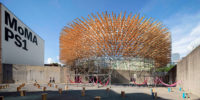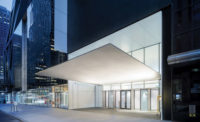On October 21, New York’s Museum of Modern Art (MoMA) shows off its new girth with the public opening of its expanded and renovated galleries, by Diller Scofidio + Renfro in collaboration with Gensler. The current $450-million redo, 15 years after one designed by Yoshio Taniguchi (RECORD, January 2005), marks the latest in a series of additions and reconfigurations that MoMA has undertaken since 1939, when it first moved into the new museum it commissioned at 11 West 53rd Street in Manhattan. Up from the previous 128,000 square feet of gallery space, the museum will now claim 166,00 square feet (and a total of 708,000 square feet overall for the institution). MoMA is one big momma—and while it covers a large chunk of its city block, it is now hemmed in from further expanding its footprint by an office tower to the west and a church to the east.
The museum’s mission to show its impressive collection of historic modern art, as well as contemporary work, has long propelled its growth. But ongoing acquisitions—and the additional imperative to include more art of other cultures, ethnicities, and genders—dictated expansion. In a shift of strategy, the museum also decided to reorganize galleries across disciplines so that painting, photography, film, drawing, and design can now rub shoulders in the same spaces, and reinforce certain thematic ties.
For the architectural community, the new MoMA will be particularly scrutinized for two reasons: first, the overall design, which Architectural Record will cover in a subsequent article, and second, the fate of the design collection within the new mix-and-match curatorial approach. The building has now expanded west from the Taniguchi building into the lower levels of the soon-to-open, 82-story apartment tower, 53 West 53, by Ateliers Jean Nouvel—which, in the process, sparked a major controversy by destroying the Folk Art Museum designed by Tod Williams Billie Tsien (RECORD, May 2002) that was unluckily wedged between MoMA and the site of the tower.
During an early preview, RECORD visited the new galleries for architecture and design scattered throughout the existing and expanded floors. For decades, that department, established in 1932 as the first of its kind in the world, had its own dedicated “real estate” within the museum. Then in 2016, a mini-tempest erupted when MoMA announced that after its expansion, the architecture and design collections would no longer occupy their own discrete enclave, but would be integrated with other media. A test case was the show From the Collection: 1960-1969, on view from 2016 to 2017, with curators from all departments collaborating to create an integrated installation. The result did not please the design community, many of whom felt that the odd drawing or model placed among other art works reduced architecture and design objects to mere stepchildren of the more privileged paintings and sculpture.
After that show, MoMA rethought its initial plan and adopted what architecture curator Martino Stierli describes as a Venturi-esque “both/and” approach for architecture and design: giving the department autonomous galleries, yet encouraging photographs, films, paintings, and sculptures to be tucked in where relevant. For the opening, seven galleries devoted to architecture and design from the museum’s permanent collection are on view—not together, but rather in different spaces on the first, second, fourth, and fifth floors. MoMA says these separate galleries will be reserved for the department, with the exhibitions changing every 18 months.
Yet a didactic aspect—a chronological history of design since the late 19th century—is gone; instead, the galleries are organized by such themes as Vertical City or Building Citizens. Large-scale, temporary shows will be displayed in special exhibition spaces on the sixth and third floors.
Different curators worked with Stierli to plan the current shows, each taking on specific areas of expertise. Barry Bergdoll, the Columbia University art historian who formerly held Stierli’s post, has curated two: one delving into America’s invention of the skyscraper (Vertical City) and the other examining how modernist architects designed non-traditional art museums (Architecture for Modern Art). Both exhibitions make extensive, though not exclusive, use of the museum’s Frank Lloyd Wright and Mies van der Rohe archives.
Stierli installed another show, Architecture Systems, to demonstrate how technical and planning approaches shape the built environment at every scale. The highlight is a 17 by 12–foot fragment from the original facade of the United Nations building, shown against a clip from Jacques Tati’s film, Playtime (1967), a futuristic spoof that today seems very au courant.
A gallery of contemporary work, Building Citizens, includes models, drawings, photos, and a film that curator Sean Anderson uses to comment on how architects’ visions do (or do not) reflect societal concerns. Under the rather amorphously worded rubric is everything from documentation of Alvaro Siza’s social housing in Porto, Portugal (1974-77) and Peter Eisenman’s drawings for House Six in Cornwall, Connecticut (1972-75) to an acrylic model for a project, From Hardware to Soft Form (2002), by Winka Dubbeldam. Nearby are photos of Amanda Williams’s Color(ed) Theory Suite, (2014-16), her project of brightly painted abandoned houses on Chicago’s South Side.
Two galleries installed by curator Juliet Kinchin return to presenting historical works: one, Designs for Modern Life, highlights the Frankfurt Kitchen by Margarete Schütte-Lihotzky (1930), while Taking a Thread for a Walk, focuses on textile art from the 1890s to the 1970s, by Anni Albers, Sheila Hicks, and others.
On the ground floor footprint of the old Folk Art Museum is a gallery free of charge to the public. Here curator Paola Antonelli’s vibrant installation, Energy, shows that force as interpreted in design works, such as Ingo Maurer’s Porca Miseria! Chandelier (1994).
In the new blurring of boundaries across disciplines, design pops up occasionally in the fine art galleries: Sou Fujimoto’s mini-models, Architecture is Everywhere (2015) is in a temporary installation on the top floor.
But the question remains: does dispersing the architecture and design galleries throughout the immense museum create an overall understanding of history? Not likely. Maybe an unsuspecting visitor, wandering through room after room of paintings and drawings in search of Monet’s Water Lilies, will stumble onto a gallery devoted to architecture, which will spark a fresh interest in our oft-ignored discipline. In an even bigger, reimagined museum, it is challenging to find your way, and without certain identifiable “neighborhoods,” MoMA risks being more disorienting, not less. Let’s see how the community of architects and the public respond.










Post a comment to this article
Report Abusive Comment